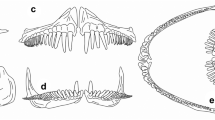Abstract
Many animals that possess a gizzard swallow stones or sandy grit, supposedly to aid in the mechanical breakdown of food. While this has been well documented in the literature, our study is the first to report the presence of stones in the gizzard of king penguin chicks. We found stones, so called ‘gastroliths’, in the pyloric region of the gizzard, the part of the digestive tract that is specialised for the mechanical breakdown of food. Stones were already present in the gizzard of chicks and, hence, during the first year of the life of king penguins, which is spent on land. Some chicks were found to have more than 130 stones (0.5–22 mm in size) in their gizzard. The gastroliths we found in king penguins are of the same geological origin as rocks present at the colony, which suggests that birds swallowed them there. The functional role of gastroliths in penguin chicks and adults is still unknown. We discuss the potential roles that these gastroliths might play in king penguins (i.e. aid in digestion, buoyancy control during foraging at sea, adaptation to fasting).


Similar content being viewed by others
References
Barrat (1976) Quelques aspects de la biologie et de l’écologie du Manchot royal (Aptenodytes patagonicus) des Iles Crozet. Corn Nat Fr Res Antarct 40:9–52
Boswall J, Maciver D (1975) The magellanic penguin Spheniscus magellanicus. The biology of penguins. MacMillan Press, Stonehouse B. Bristol, pp 271–306
Cherel Y (1995) Nutriment reserves storage, energetics, and food consumption during the prebreeding and premoulting foraging periods of king penguins. Polar Biol 15(3):209–214
Chevallier L (1980) Notice géologique au 1:50000 de l’île de la Possession, îles Crozet. TAAF, LGFSA. pp 16
Clausen A, Pütz K (2003) Winter diet and foraging range of gentoo penguins (Pygoscelis papua) from Kidney Cove, Falkland Islands. Polar Biol 26:32–40
Cooper J (1985) Adélie Penguins breeding in eastern Enderby Land, Antarctica. Emu 85:205–206
Descamps S, Gauthier-Clerc M, Gendner J-P, Le Maho Y (2002) The annual breeding cycle of unbanded king penguins Aptenodytes patagonicus on Possession Island (Crozet). Avian Sci 2:87–98
De Villiers MS, De Bruyn PJN (2004) Stone-swallowing by three species of penguin at sub-Antarctic Marion Island. Mar Ornithol 32:183–184
Figuerola J, Mateo R, Green AJ, Mondain-Monval JY, Le Franc H, Mentaberre G (2005) Grit selection in waterfowl and how it determines exposure to ingested lead shot in Mediterranean wetlands. Env Cons 33:1–9
Godin AJ (1967) Test of grit types in alleviating lead poisoning in mallards. US Fish and Wildlife Service Special Science Report: Wildlife 107
Hocken AG (2005) Necropsy findings in yellow-eyed penguins (Megadyptes antipodes) from Otago, New Zealand. N Z J Zool 32:1–8
Kent S, Seddon J, Robertson G, Weinecke BC (1998) Diet of adélie penguins Pygoscelis adeliae at Hirley Island, East Antarctica, January 1992. Mar Ornithol 26:7–10
Le Bohec C (2007) Life history strategies in long-lived birds: the king penguin. Ph.D. Thesis, Louis Pasteur University, p. 290
Le Bohec C, Gauthier-Clerc M, Le Maho Y (2005) The adaptative significance of crèches in the king penguin. Anim Behav 70:527–538
Lee DE, Hamman MG, Black JM (2004) Grit-site selection of black brant: particle size or calcium content? Wilson Bull 116:304–313
Maddock L (1994) Stone, bone or blubber? Buoyancy control strategies in aquatic tetrapods. In: Maddock L, Bone Q, Rayner JMV (eds) Mechanics and physiology of animal swimming. Cambridge Univ. Press, London, pp 151–161
Rand RW (1960) The biology of guano-producing sea-birds. The distribution, abundance and feeding habits of the Cape penguin, Spheniscus demersus, off the south-western coast of the Cape Province. Invest Rep Sea Fish Res Inst, Cape Town 41: 1–27
Sato K, Naito Y, Kato A, Niizuma Y, Watanuki Y, Charassin JB, Bost C-A, Handrich Y, Le Maho Y (2002) Buoyancy and maximal diving depth in penguins: do they control inhaling air volume? J Exp Biol 205:1189–1197
Skead DM, Mitchell RJH (1983) Grit ingested by waterfowl in relation to diet. S Af J Wildl Res 13:32–34
Splettstoesser J, Todd FS (1999) Stomach stone from emperor penguins Aptenodytes forsteri colonies in the Weddell Sea. Mar Ornithol 27:97–100
Taylor MA (1993) Stomach Stones for Feeding or Buoyancy? The Occurrence and Function of Gastroliths in Marine Tetrapods. Phil Trans R Soc London 341:163–175
Trost RE (1981) Dynamics of grit selection and retention in captive mallards. J Wildl Manag 45:64–73
Wings O (2007) A review of gastrolith function with implications for fossil vertebrates and a revised classification. Acta Palaeontol Pol 52(1):1–16
Ziswiller V, Farner DS (1972) Digestion and the digestive system. In: Farner DS, King JR, Parkes KC (Eds) Avian biology, vol 2. Academic Press, New York, pp 343–430
Acknowledgments
This work was supported by the Institut Polaire Français-Paul-Emile Victor (IPEV), by the project Zones Ateliers of the Programme Environnement Vie et Société of the CNRS, and by grants from the French Ministry for Foreign and European Affairs-Lavoisier (to C.L.B.). We are grateful to Manfed Enstipp, Jean-Patrice Robin, Sylvie Geiger, Nicolas Hanuise, Matthieu Guillemain and two anonymous referees for constructive comments on the manuscript. This study was approved by an independent Ethics Committee appointed by the Institut Polaire Français-Paul-Emile Victor.
Author information
Authors and Affiliations
Corresponding author
Rights and permissions
About this article
Cite this article
Beaune, D., Le Bohec, C., Lucas, F. et al. Stomach stones in king penguin chicks. Polar Biol 32, 593–597 (2009). https://doi.org/10.1007/s00300-008-0558-1
Received:
Revised:
Accepted:
Published:
Issue Date:
DOI: https://doi.org/10.1007/s00300-008-0558-1




